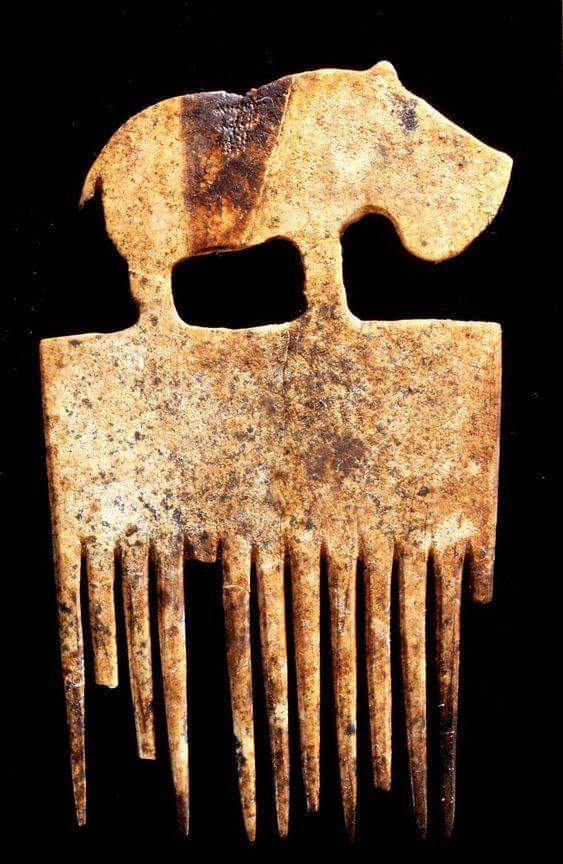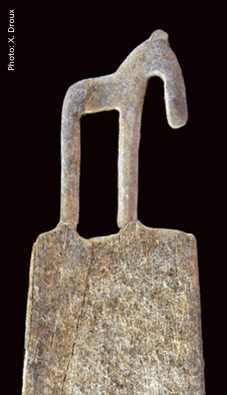
 |
| "Hippo comb" from HK6 Tomb 72 at Hierakonpolis |
A spot on the top of the hippo figure’s back seems to have been intentionally burnt. This comb was found just above the remains of the tomb owner’s pelvis.
 |
 |
| A man standing with a leashed young hippo on Gebelein painted linen, Gebelein, ca. 3600 BC | Pot from HK6 Tomb 72 at Hierakonpolis |
Three hippos (two young and a newborn) were buried at HK6: each in Feature H, the vicinity of Tomb 2, and Tomb 12.
 |
| "Donkey comb" from HK6 Tomb 72 at Hierakonpolis |
HK6 Tomb 72 is set within a large wooden structure (Structure F). The body of Tomb 72 owner was highly disturbed. Bones of a young person, 17-20 years of age, were found scattered in the upper fill and surrounding areas. Only some fingers and a part of the pelvis were found on the floor of the tomb. The majority of the objects date the tomb to the Naqada IIA-B period, roughly 3700-3600 BC; however, many show evidence of use prior to deposition.
The almost complete removal of the human bones from the floor of the tomb, while many objects were left in place suggests that the grave had been violated soon after the owner's death. This seems to have been an act of aggression against the tomb owner, rather than merely robbery. The wooden building above the tomb was then burnt down, along with other posts within Structure F. It was later restored in the early First Dynasty.
The orientation of Structure F and Tomb 72 suggests that it was the main tomb for the complex of tombs on the eastern side of the cemetery, which included the burials of several young humans, a large male leopard, wild cattle, baboons, sheep with modified horns, goats, dogs and an ostrich. Thus the owner of Tomb 72 may have been one of ancient Hierakonpolis’ Predynastic kings.
dLugal-banda
Sumerian: Lugal = King, Sumerian: banda = young, junior
HK6 Tomb 32, dated to to the Naqada IIA-B period, contained the skeletal remains of as many as eight individuals, two or possibly three of whom had been exposed to fire. Based on isolated cranial fragments, the cremated remains appear to belong to a male and a female. A third individual is represented by a non-adult hand bone (a first metacarpal), sex indeterminate. Discoloration of the fragments in black and reddish brown hues is consistent with heat exposure within the 200–600˚C range. There was no indication of fire within the tomb itself.
To the north of Tomb 32, a shallow pit contained the remains of two dogs (Feature D), and to the south, a deeper pit held the disturbed remains of a juvenile hippopotamus (Feature H).
References:
http://www.hierakonpolis-online.org/index.php/explore-the-predynastic-cemeteries/hk6-elite-cemetery/tomb-72May 12, 2024 Takahiko Nakagawa